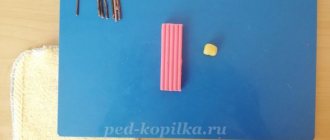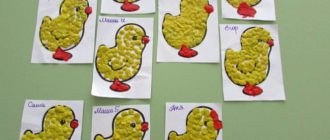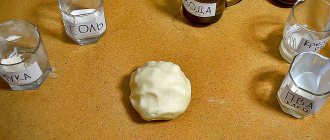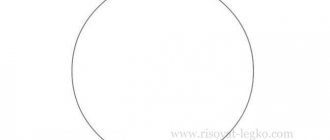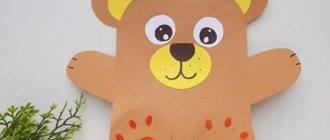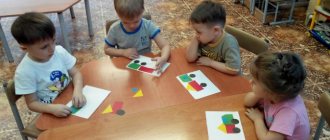Features of conducting appliqué classes in the middle group
Children in the middle group quickly gain more cognitive experience, and their imaginative ideas are enriched in the process of play. This naturally leads to the development of visual skills. At the age of four or five years, children already know how to properly hold scissors in their hands and cut a piece of paper in a straight line. Children are able to cut out round and oval shapes from a square and a rectangle, respectively.
At this age level, the skills of accurate gluing and composing a beautiful composition are improved - children learn to harmoniously place an image on a base, put together elementary patterns from geometric shapes and plant elements.
The task of the teacher in the middle group is to clarify ideas about the shape of objects (in this case, trees, flowers). In this case, such techniques as moving the hand along the contour, including special didactic games in the lesson (for example, make a flower from parts - petals, stem, leaves), observing environmental objects, looking at pictures and illustrations are used. The teacher shows the children various options for making parts of the same object.
Preschoolers learn to make flowers of various shapes from different geometric shapes
In addition, the teacher’s task is to develop a sense of color in students, to select contrasting shades that will look beautiful next to each other.
At the same time, in the middle group, children learn to perceive the teacher’s word: relying on the children’s experience, knowledge and skills, he can sometimes explain the task without using visual actions. For example, when creating an image of a magical garden, the children’s attention is drawn to the unusual shape and color of the parts from which trees and flowers can be made, while the teacher does not show the children individual elements.
Children are always inspired by collective activity, and joint appliqué is easier for them than drawing. The guys like to create an overall picture; in the course of work, they consult with each other and help their comrades.
During the process of children's creativity, the teacher gives children advice: which elements to choose, how best to arrange the details, but refrains from direct instructions.
The teacher must remember the individual approach: to stimulate the activity and independence of children. Since working with scissors at the age of four or five years is still quite difficult, children who experience difficulties should additionally be shown key cutting techniques on a separate sheet of paper.
Before starting to create the “Magic Garden” composition, the teacher invites each child to think about what object he wants to cut out and glue to the general background. Those guys who find it difficult to choose should submit an idea for creativity.
In the middle group, sufficient attention is paid to the analysis of the work received. The children are invited to admire the created picture, talk about it, and decorate the group room with it. The teacher highlights particularly expressive details, notes their interesting shape or color scheme. At the same time, you should not focus children’s attention on unsuccessful elements.
Preparing for the lesson, making parts
In the middle group, the main work on preparing details for the applicative lesson is carried out by the teacher. He should take care of a large size base (for example, a sheet of Whatman paper) painted in a suitable background. The teacher can offer the children ready-made shapes and silhouettes of trees, and they, in turn, will decorate them with various elements, which they will then cut out themselves.
The teacher offers the kids ready-made silhouettes of trees, and they decorate them with suitable elements
If the theme of the lesson sounds like “Wonderful Tree,” then the kids are offered a pre-drawn or glued trunk of an unusual color, with patterns (kids can stick them on as they work), which needs to be supplemented with the necessary details: leaves, fruits, birds, insects, etc. .
Children can stick unusual leaves, fruits, insects, birds, etc. onto a pre-prepared trunk.
To create leaves, fruits, etc., the teacher offers preschoolers paper squares, rectangles, and triangles. At the same time, the material on the table for collective creativity should be evenly distributed: each child should have free access to it (put several trays with parts).
Preschoolers work in subgroups: the material should be accessible to every child
You can offer the guys ready-made silhouettes of details for decoration, for example, original carved leaves. In this case, you need to focus on the beautiful arrangement of elements and a harmonious combination of colors.
The basis of the image of a fairy garden can be beautiful leaves of a bizarre shape.
What types of appliqué are appropriate to use to create the composition “Magic Garden”
When creating the image of a magical garden, students can be offered various applicative techniques. In addition to the traditional flat appliqué, you can include three-dimensional elements in the composition, which always look original. This could be leaves that are not completely glued, butterfly wings, grass in the form of a strip of paper with cuts that remain unglued, or bending of some parts of flat parts.
Application with volumetric elements
A mosaic appliqué, for example, made from lumps of multi-colored napkins, also gives a volume effect. For the development of fine motor skills, the cutting technique is perfect, as well as bulk application (using cereals or coarse salt).
Application using bulk and breaking techniques
Kids will be happy to create an applique collage - they will paste cut-out images from magazines and postcards onto the base. By the way, colorful store catalogs can also be useful for this purpose.
Collage
The most suitable material for the job, including the base
Such an unusual lesson topic as “The Magic Garden” involves the use of a variety of materials - both conventional and non-standard. So, in addition to traditional shades of paper, children should be offered gold and silver colors and velvet paper.
In addition, to make work more interesting and exciting for children, you can provide them with fabric parts, natural and waste materials. These can be satin ribbons, tree leaves, seeds, fluff, shiny candy wrappers, chocolate wrappers, cut-out elements from juice and milk cartons, etc. An interesting three-dimensional effect is achieved by using foam rubber or cotton wool.
Photo gallery: materials for the application “Magic Garden”
Application using waste material (chocolate wrappers, juice packaging, etc.)
Fabric applique
Foam applique
Application using natural material
Elements of drawing and modeling will help to complement the application and make it more original.
Application with drawing elements
Work program “Application” (middle group)
arouse interest in various buildings located around the kindergarten (houses in which the child and his friends live, school, cinema);
attract children's attention to the similarities and differences of different buildings, encourage them to independently identify parts of the building and its features; consolidate the ability to notice differences in buildings that are similar in shape and structure (shape and size of entrance doors, windows and other parts);
encourage children’s desire to depict real and fairy-tale buildings in applications;
organize a visit to the museum (together with parents), talk about the purpose of the museum;
develop interest in visiting puppet theaters and exhibitions;
consolidate children's knowledge about books and book illustrations; introduce the library as a storage center for books created by writers and poets;
introduce works of folk art (rhymes, fairy tales, riddles, songs, round dances, chants, products of folk arts and crafts);
cultivate a caring attitude towards works of art.
Visual activities
continue to develop children’s interest in visual arts; evoke a positive emotional response to the cut and paste offer;
continue to develop aesthetic perception, figurative ideas, imagination, aesthetic feelings, artistic and creative abilities;
continue to develop the ability to examine and examine objects, including with the help of hands;
enrich children's ideas about fine art (illustrations for works of children's literature, reproductions of paintings, folk decorative art, small sculpture, etc.) as the basis for the development of creativity; teach children to identify and use means of expression in application;
continue to develop the ability to create collective works in application;
strengthen the ability to maintain the correct posture: do not hunch over, do not lean low over the table; sit freely without straining; teach children to be neat: keep their work place in order, clear everything from the table after finishing work;
teach to be friendly when evaluating the work of other children.
Application
cultivate interest in the application, complicating its content and expanding the possibilities of creating a variety of images;
develop the ability to hold and use scissors correctly; teach cutting, starting with developing the skill of cutting in a straight line, first short and then long strips; learn to compose images of different objects from stripes (fence, bench, ladder, tree, bush, etc.); learn to cut round shapes from a square and oval shapes from a rectangle by rounding the corners; use this technique to depict vegetables, fruits, berries, flowers, etc. in appliqué;
Specific options for the collective composition “Magic Garden” in the middle group
The collective application “Magic Garden” is offered to middle school students at the end of the school year (May). By this time, the guys already had skills in this kind of work - in the first half of the year (November) they created a joint composition “Basket of Mushrooms”.
During the lesson, preschoolers are given freedom of creativity; they independently determine the content of the image: they include strange trees, flowers in the picture, it can even be unusual animals, birds and insects (at the request of the children). The main goal of such a lesson is not only to consolidate visual skills, but, above all, to develop imagination and figurative perception.
You can make the topic of the lesson more specific and invite the children to create a wonderful apple orchard where apple trees with unusual fruits will grow. The teacher prepares a base in advance with drawn tree trunks and crowns, and each child cuts out an apple of the color and size he likes (they can be, for example, blue or silver) and sticks it on any place.
The theme can also be described as a wonderful tree: in this case, kids decorate one large blank (trunk and crown) with strange fruits and leaves.
How to play up the beginning of a lesson in an interesting way
At the age of four or five years, children do not yet separate play from direct educational activities, therefore, in order to interest them in a creative activity as much as possible, the teacher must think through an exciting start to the lesson. For example, a group may receive a letter from a good wizard. He has a wonderful garden with unusual trees, on which fabulously beautiful flowers bloom and delicious fruits grow. But due to the tricks of the evil witch, the flowers did not bloom this year. The kids should help - decorate the trees with their strange flowers.
Another option is that a girl Masha comes from a fairyland to visit the children (a doll is on display). She tells an interesting story. One day she went for a walk in a wonderful forest to admire its beauty: all the trees there were bright and elegant. And so she walked and met one sad tree: it was worried that it did not have beautiful flowers and fruits. Masha felt very sorry for the tree, but she didn’t know how to help it—she couldn’t do it alone.
When telling preschoolers such stories, it is necessary to provide them with illustrations for them - pictures depicting magical nature. These can be gardens and clearings where apple trees with huge fruits grow, trees with soft lilac foliage, bizarrely shaped plants, among which fairy-tale characters (fairies, unicorns, anthropomorphic insects, etc.) walk.
Photo gallery: pictures depicting magical scenes of nature
A tree with huge roots and wonderful fruits
Apple tree with huge delicious apples
Fairies and unicorns are located between the delicate trees
Multi-colored trees, among which cute bugs and birds rest
Kids always love to transform into representatives of some profession, fairy-tale heroes. Therefore, they will enthusiastically accept the teacher’s offer to become wizards for a while and create the image of a magical garden, which they can populate at will with unusual trees, flowers, birds, beetles, and butterflies.
On the eve of the lesson, it is good to invite the children to complete puzzles on the theme “Garden”.
Before a creative activity, it is good to offer preschoolers puzzles on the relevant topic.
You can start a visual arts activity with a short fairy tale or an episode from a suitable work (after all, too long a story will tire the children). For example, in the fairy tale story “The Magic Garden” by Elena Zheryakova, the girl Lilya has a dream in which she goes to a wonderful castle and meets her cat there. It turns out that the animal can talk and invites its owner to take a walk in the garden. Lilya sees beautiful flowers: some her mother grew at the dacha, and others she has never seen before. There was a wonderful smell in the garden, and a bright rainbow shone in the sky. The girl's mood became simply wonderful. The cat told her about the names of flowers and various interesting facts from the life of plants (it was not for nothing that in the summer they took her with them to the dacha). She also told Lila that this garden is magical: if you look at the flowers and inhale their wonderful aroma, then all the bad things will be forgotten.
The following fairy tale with the same name, which was invented by schoolgirl Margarita Efimova, is also suitable for the lesson. One family had a large garden where various fruit trees grew: apple and pear trees, plums and apricots. And one day beautiful birds flew there. The son grabbed a stick and began to drive them away. The father scolded the boy. And the next day the garden became sad, and all the fruits became bitter. It turns out that the birds were magical and sang magical songs to the trees, but now they are offended and no longer come. Mom told her son that he should go into the forest, find the birds and apologize to them. The boy did so, and then the garden came to life again and the fruits became tasty.
The story of Elena Pishchulina-Volkova “A Tale of Love” also deserves attention. Magic Garden" (intended for children and adults). Here we are talking about a wonderful, kind garden that talked with the sun.
“Sunlight took Joy and Warmth by the hands (although a little warmth always remained to warm the conversation) and walked quietly and calmly through the Garden. The warmth caught up with them a little later, having already warmed the communication between the Garden and the Sun, it hurried after Joy and Sunlight. Oh, my God! How wonderful it was in this Garden - everyone loved each other in it: trees, flowers, cheerful bees and light-winged butterflies, carefree dragonflies, bugs, and spiders - after all, the Sunlight was nearby, and the Warmth entered the Soul of the Garden and warmed her, and the Joy that the guests brought filled the hearts of all its inhabitants.”
After reading such works, you can invite the children to create images of anthropomorphic trees inhabiting an unusual garden: glue on them, among other details, eyes and a smile (the teacher provides the details).
To convey imagery and expressiveness, it is good to include artistic words (riddles, poems, sayings) in the lesson.
Birds, bees, flowers, trees, They all live in our wonderful garden, We invented this garden ourselves In our little kindergarten. We all worked together and now, this garden on paper is blooming. Very bright, beautiful, wonderful, Made by our skillful hand.
Novruzova A.L.
https://mbdou6-krop.ru/?p=3043
Kids love outdoor games and dynamic physical education. They must be used in class, choosing the appropriate topic.
Physical school
| Trees have grown in the field. It's good to grow in freedom! | Stretching - arms to the sides |
| Everyone is trying, reaching for the sky, reaching for the sun. | Hands stretching up |
| A cheerful wind blew, the branches began to sway, | Children waving their hands |
| Even the thick trunks bent to the ground. | Forward bends |
| Right and left, back and forth - This is how the wind bends the trees. | Tilts left and right, forward and backward |
| He turns them, he turns them. When will there be a rest? | Torso rotation |
| The wind died down. The moon has risen. There was silence. | Children sit at tables |
| They raised their hands and shook them - These are trees in the forest. | smooth swaying of arms raised up |
| Arms bent, hands shaken - The wind knocks down the dew. | shaking hands in front of you |
| Let's wave our hands to the sides, smoothly - These are the birds flying towards us. | horizontal, simultaneous movements of the arms to the right - left |
| We’ll also show you how they sit down – the wings are folded back | Children sit down and fold their hands behind their backs |
Finger gymnastics “The hazel tree bent its branches...”
| The hazel tree bent its branches and gave nuts to all the animals. | stroke their hands |
| Here's a nut for the little squirrel, Here's a nut for the mouse, Here's a nut for the hamster, Here's a nut for the chipmunk, And here's a nut for me. | alternately massage fingers |
| He cooked it friends | rub your palms together |
Physical school
| The stems were straightened and the branches were stretched out. | Raise your hands up |
| They straightened out the leaves and rustled the leaves. | Wiggle your fingers |
| Gymnastics for the stem | Torso tilts left and right, forward and backward |
| Gymnastics for the roots | Stretched the right leg - rotation of the feet, extended the left leg - rotation of the feet |
| Washing leaves and stems in the rain | Raise your hands up, spread your fingers, expose your palms to the rain, spin around |
Outdoor game "Living Flowerbed". Children are divided into three teams: Golden Balls, Daisies, Marigolds and Marigolds. In the center of the flowerbed there are golden balls - they are the tallest. The guys raise their hands up and spin around themselves. The second circle is the marigolds; they form a dance around the golden balls. And the third circle is baby marigolds: they squat down because these flowers are the shortest.
The wind blew, the flowers came to life and moved: golden balls were spinning, marigolds were moving in a circle in one direction, and marigolds were moving in the other.
Class notes
| Author's full name | Title of the abstract |
| Selishcheva T. | “Magic Garden” (collective application) Educational objectives : learn to create a collective picture, independently choosing the content of your image (tree, flower), consolidate the ability to cut with scissors in a straight line, round the corners of a square and rectangle. Developmental tasks : develop figurative representation, imagination, compositional skills, color perception, continue to practice the ability to carefully glue parts to the base. Educational objectives : to cultivate interest in the natural world and art. Integration of educational areas : “Artistic creativity”, “Cognition”, “Communication”, “Socialization”, “Health”. Handouts: brown rectangles (for the trunk), green and yellow squares of different sizes (crown and fruits), glue, glue brushes, scissors, oilcloth. Progress of the lesson: The teacher invites the children to close their eyes and mentally find themselves in a magical garden, where fabulous apple trees with golden apples grow, and wonderful birds fly next to them. The teacher recalls with the children the structure of the tree (trunk, crown, leaves, fruits), the color of each part. Techniques for cutting a triangle from a rectangle to obtain a crown are demonstrated (fold the rectangle in half and cut off the corners from the middle to the edges). The part is decorated with cloves. Apples are cut from a square by rounding the corners. Finger gymnastics “The hazel tree bent its branches...” is carried out. Before children work independently, the teacher reminds them how to hold scissors correctly in their hands. Productive activity of preschoolers. Examination of the finished composition: analyzes what the trees have in common, and how certain details were cut out. The teacher invites the children to come up with a story for their application. |
| Shornikova E. | "Magic Garden" (collective application) The teacher invites the preschoolers to remember what they saw during a walk in the kindergarten. The children are invited to look at a branch of a plant with blossoming flowers. The teacher asks a riddle about the garden:
Conversation with children on the topic: how they imagine a magical garden. A picture with a suitable image is shown and questions about it. The teacher explains techniques for cutting out and arranging flowers (they need to be glued to the crowns of trees). Independent work of preschoolers. Kids who quickly complete the task are additionally invited to cut out butterflies, bugs and flowers for the grass). |
Lesson notes on the application “MAGIC GARDEN”
Multi-colored butterflies, furry bumblebees and bees flutter over the flowers. Dragonflies with big eyes and sparkling wings, as well as many small insects, fly quickly. If you listen closely, you can hear what they are talking about. Everyone is busy collecting nectar and pollinating beautiful flowers to add new colors to their petals. After all, it is known that when mixing colors, new shades are obtained.
Unusually brightly colored birds fly in a magical garden and sing melodious songs about love and happiness.
The feathers of these birds, if they fall on your hand, like magic wands, make any wish come true. Only the desire must be very, very important and the most genuine and kind. Evil desires are not fulfilled.
There are a lot of trees in the garden. They, too, like everything in this garden, are magical. The trees bloom all year round and bear fruits that you can only taste here. Pick one and feel its heaviness in your hands, the smoothness and warmth of its surface. First you need to inhale the extraordinary aroma, which increases the brightness of the colors around. It seems that this beauty around could be even brighter? It turns out it can! After this, a desire arises to draw, write poetry or music, and dance.
Now try to bite off a piece of this fruit. ABOUT! What an extraordinary taste, the juice begins to flow down your chin and hands.
A light breeze that gently touches you will immediately advise you to run to the fountain, which is located in the center of the garden, and wash your hands and face.
The fountain is very easy to find - it can be seen from afar. The jets of the fountain sparkle and shimmer so much in the sun and rise so high above the treetops that it seems as if the spray reaches the light clouds that fly over the garden. The clouds laugh merrily and thank the fountain for such a shower.
The fountain nourishes and refreshes the entire garden and all its inhabitants. It is very important for everyone. But he is not arrogant, but simply performs his task and is very proud of it. And when they say “thank you,” it begins to sparkle even brighter and becomes even higher and more powerful.
Dip your hands into its water and feel its coolness and life-giving power. Rinse your face and expose it to the breeze to dry it.
The splashes of the fountain form a beautiful rainbow under the sun's rays. She, like a gate, opens the way to the farthest corners of the Magic Garden.
The garden invites you to go further to discover its secrets. In one of its corners there is a small lake with very clear and clean water. Through the water you can see the snow-white sand at the bottom and streams of water that rise from the bottom, swirling and creating oily pearlescent stains on the surface of the lake. It is the Life-giving Spring that emerges from the bottom of the lake.
